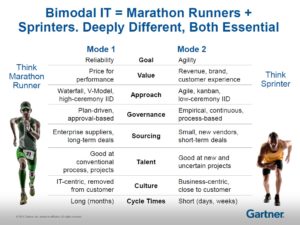Bimodal IT: Why It Matters
A few months ago, I published a blog post about hybrid models and promised to follow up with posts on bimodal IT and organizational agility. It’s taken me a long time to circle back… I’d like to be able to hide behind the amount of training courses I’ve been leading (which would probably be a viable excuse), but the main reason it has taken me this long is because I’ve been talking with different practitioners who have differing views of what bimodal actually means. I wanted to understand their perspectives and make sure I gave it time to settle before I threw down on the topic.
If you’re not familiar with the idea of bimodal, it entered the conversation in November of 2015 when Gartner started to post about the topic. You can find more information from Gartner if you follow the links at the end of this article.
At a highly abstracted level, bimodal comes from the idea that in some organizations, it is unrealistic to assume we will reach a point where we can migrate entirely to Agile. In some environments, it just may not make sense to make the switch. There are many reasons a business might decide to make, or not make this shift, and Gartner often provides the graphic below to help illustrate the differences between the two modes.

IMO (and I am speaking for myself, not necessarily my employer), the introduction of bimodal is a significant event. Also IMO, I think it is easy to miss the significance of this event for two reasons.
1) In a way, Gartner speaking up for bimodal says it’s okay to not be 100% Agile.
For a period of time, an increasing section of the population has been marching under the quest to reach the nirvana of Agility. In many organizations, this drive was bottom-up and rose from teams and/or coaches. In some cases, it was top-down and driven by senior management. Often times, management’s interest in agility rose not from an imperative to reach a state of agility, but from an organization’s need to employ practices that provide better information quicker, which allows them to make more informed decisions as to how they run their business.
Many organizations have made the switch, and that’s great. However, there are many organizations that may not be able to make it all the way to the promised land (at least not right now). For a while now, these organizations that have not made the shift have been walking around wearing the cone of shame because they’ve not been able to figure out how to convert the parts of their organization that spent more time struggling with Agile than they did delivering through the use of old methods and practices.
When Gartner legitimized a model that allowed for an innovative/agile approach to live in harmony alongside a more traditional approach, being that square peg became okay. This is something the LeadingAgile Basecamp approach has been able to support for a while now. It is important not to lose sight of the fact that the main goal is delivering value for customers. It is possible that the organizations that maintain a legacy approach will eventually decide it no longer makes sense to split their approaches. They may decide to move to a holistic innovation/agile centric approach, but maybe not… And that’s okay. While a pragmatic approach would make that pretty apparent for some, Gartner is a trusted voice for executive leadership when it comes to knowledge work.
2) Many people carry misinterpretations of what bimodal actually entails.
Gartner presents bimodal as Mode 1, which is more traditional minded approach, and Mode 2, which is a more agile/innovation/fail fast and learn driven approach. The way some articles describe bimodal make it sound a little bit like smoke and mirrors. This is because Gartner states what most organizations currently have on the traditional side are probably not Mode 1. For any given organization getting ready to make the switch, wherever they are starting from is most likely Mode 0. In order to have a traditional model co-existing peacefully alongside Mode 2, the traditional approach is going to have to change to support this new approach.
So, instead of trying to take your current approach and move to Agile, now the conversation shifts to taking what you currently have in place to shift to a new traditional model (Mode 1) and an agile/innovation-centric model (Mode 2) at the same time. This change is a major hurdle for companies embracing a bimodal approach. While complex, the value of using two approaches that support one another can have significant impacts on an organization’s performance and delivery.
For more information on Bimodal:
How to Innovate with Bimodal IT
Bimodal IT: How to Be Digitally Agile Without Making a Mess (Gartner subscription required)

